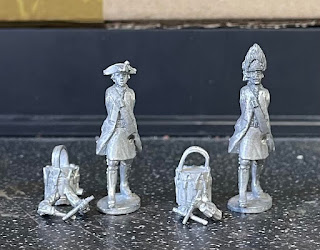It certainly seems a long time since my last post, and so much has happened in the interim period, too much to discuss now but certainly in the future.
So last year, I had a long conversation with well known eighteenth century wargamer John Ray, about what I was doing, and what my plans were for the future. My eighteen century 40mm armies were up to date, and after doing my demonstration game at Partizan, I felt that I had exhausted the scale, if not the period. I had never felt 100 percent happy with the 40mm collection, and having regularly seen John's collection on his forum, I felt that I could have done better. In the course of our conversation, John suggested that I start again, and after a few days of considering the logistics of starting from scratch, I decided to give it a go. I wanted a 30mm figure which was distinctive, anatomically accurate, but with the potential to convert. It needed to fit in with the eighteenth century linear look, but it also had to have the potential for conversion, to allow the production of vignettes. I was basically looking for a figure that was the same scale and detail as the old Phoenix ceremonial range, had the character of a Willie/Edward Suren figure, and had the look "en masse" of the old Stadden sculpts.
So I was off, I would hire a professional sculptor to do the masters, and make vulcanise moulds and cast them on my own centrifugal casting equipment. I drew up a plan in four phases which would ultimately give me reasonable armies for Prussia, Austria/Hungary/Croatia. (No point in producing half a range.) As many of the figures were quite similar for both nations, masters could be converted and cast, to reduce sculpting costs. The first phase would be Prussian/Austrian infantry and officers, second phase cavalry, third phase artillery crews and fourth phase Croats and Hungarians.
I decided that Andrew Stadden would be the ideal sculptor for my job, I contacted Andy last November, and we arranged a sculpting program, which would fit in with my casting and painting needs.I explained to Andy the style of figure I was looking for and supplied uniform specs for each model. To make make casting easier, and to allow less compromise with the sculpting, we decided to produce figures with separate arms. This is probably unique among wargaming figures, but it differentiates the figures from others that are on the market. Assembly is more time consuming, but casting is simplified and a wider variety of figures can be achieved.I also went for oval bases, which tend to cast easier than square ones.
So for my first post in some years, I would like to introduce my Prussian and Austrian 30mm infantry sculpts.




































